Russian art of the 19th century. Oil
 Bashny.Net
Bashny.Net
I take a look at an interesting collection of Russian art genre painting, which many of us today unjustly forgotten. Alex KORZUKHIN. "The Return of the city." 1870
The situation in the poor house, crawling on the floor of a shabby child, a daughter older dad brought from modest fairing - a bunch of bagels. However, many children in the family - just a picture of the three plus maybe one more in a makeshift cradle.
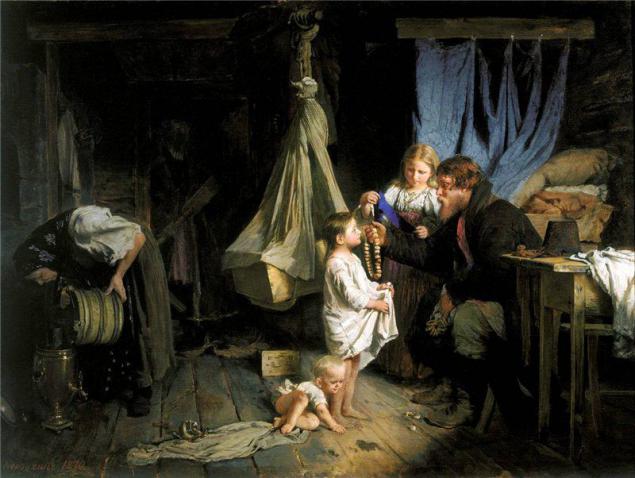
Nikolai Nevrёv. "Bargaining. Scene from a serf life. " 1866
One landowner sells the land to another girl. Impressively shows the buyer the five fingers - five hundred rubles. 500 rubles - the average price of Russian serfdom in the first half of the 19th century. Seller girls - European-educated gentleman. Paintings on the walls, books. The girl obediently waiting for their fate, others slaves crowded into the doorway and watch what the outcome of bargaining. Tosca.
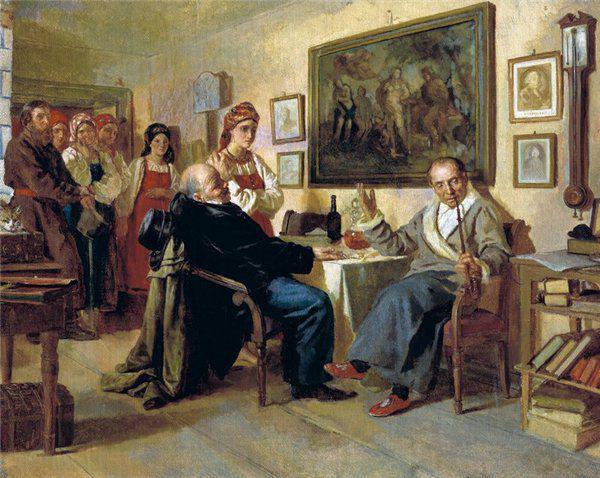
Vasily Perov. "Rural procession on Easter." 1861
Russian village of the 19th century. Orthodox Easter. All are drunk in the trash, including pop. Man in the center of the icon brings up the legs and about to fall. Some have already fallen. Fun! The essence of the picture - the commitment of the Russian people to Orthodoxy exaggerated. Perov was a recognized master of genre painting and portraiture. But this picture of him in Tsarist Russia was forbidden to display and playback. Censorship!
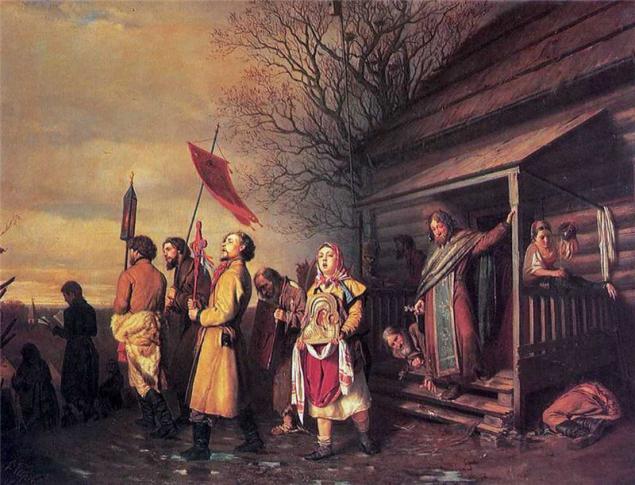
Gregory Myasoedov. "Zemstvo dinner". 1872
Times of Alexander II. Serfdom was abolished. Permission for local government - zemstvo. Peasants there too chose. But between them and the higher classes - the abyss. So - dining apartheid. Lord - in the house, with the waiters, farmers - under the door.

Fyodor Vasilyev. "The Village" was .1869
1869. The landscape is beautiful and the village, if you look closely, a beggar. Miserable home, leaky roof, buried in the dirt road.
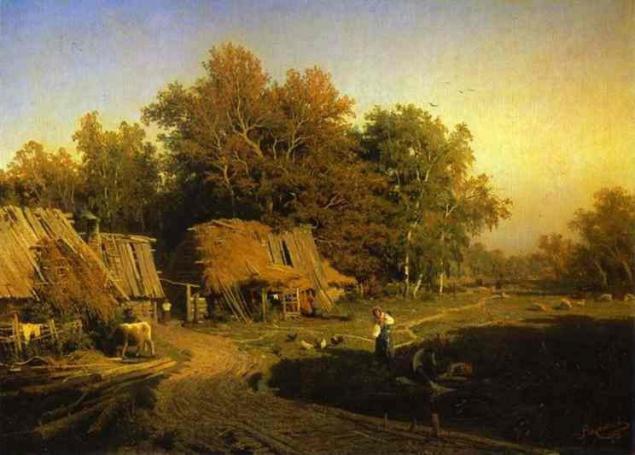
Jan Hendrik Verheijen. "Dutch village with figures of people." 1st floor. 19th century.
Well it is, for comparison :)
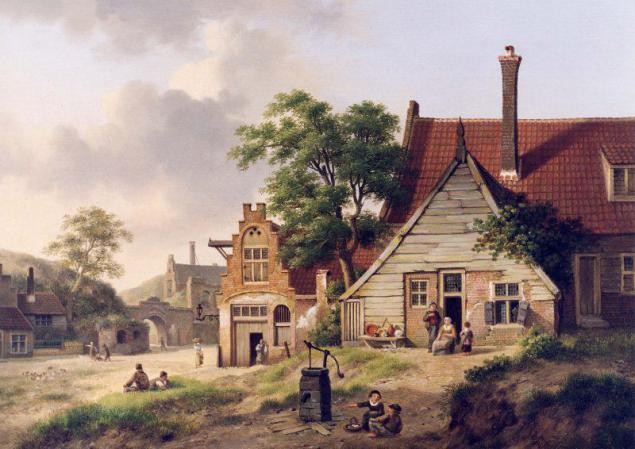
Sergey Korovin. "In the world" .1893 Mr.
This is the village of the late 19th century. Serfs no more, but there was a bundle - the kulaks. At the village meeting - any dispute between the poor and the fist. For the poor theme, apparently, vital, he almost cries. Rich fist laughs at him. Other fists in the background, too, giggling over the loser-rogue. But the poor fellow to the right of it was filled with words. Two finished Kombed already a member, have to wait for 1917.

Vasily Maximov. "The auction for the arrears" .1881-82 years.
Tax lyutuet. Royal officials let the hammer samovars, iron pots and other belongings peasant. The most heavy taxes on peasants were indemnity payments. Alexander II «Liberator" actually freed the peasants for the money - then they had to for many years to pay the native state of plots of land that they were given, along with the will. In fact, this land was the peasants before, they used it for many generations, while they were serfs. But when it became available - they were forced to pay for this land. The board had to be made in installments, right up to 1932. In 1907, against the background of the revolution government abolished these levies.
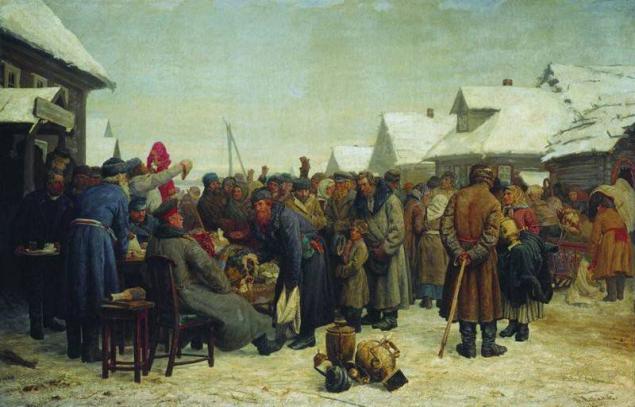
Vladimir Makovsky. "On the Boulevard". 1886-1887 was
At the end of the 19th century. Russia came in industrialization. Young people going into the city. There she goes the roof. Former life they no longer interesting. And this young laborer - not interested even his wife, peasant, came to him out of the village. She did not move forward. Girl in horror. Proletarian with an accordion - all of FIG.
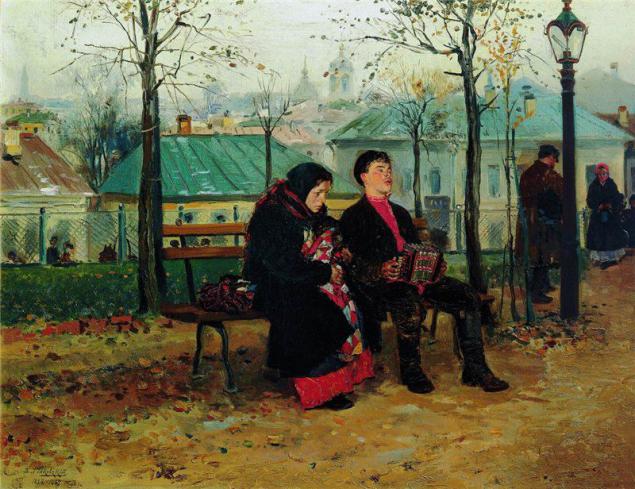
Vladimir Makovsky. "Rendezvous". 1883
In the village of poverty. Kid gave "to the people." Ie sent to the city to work for the owner, who operates child labor. My mother came to visit her son. Tom obviously unsweetened live, the mother sees everything. The kid eats greedily had brought a loaf.
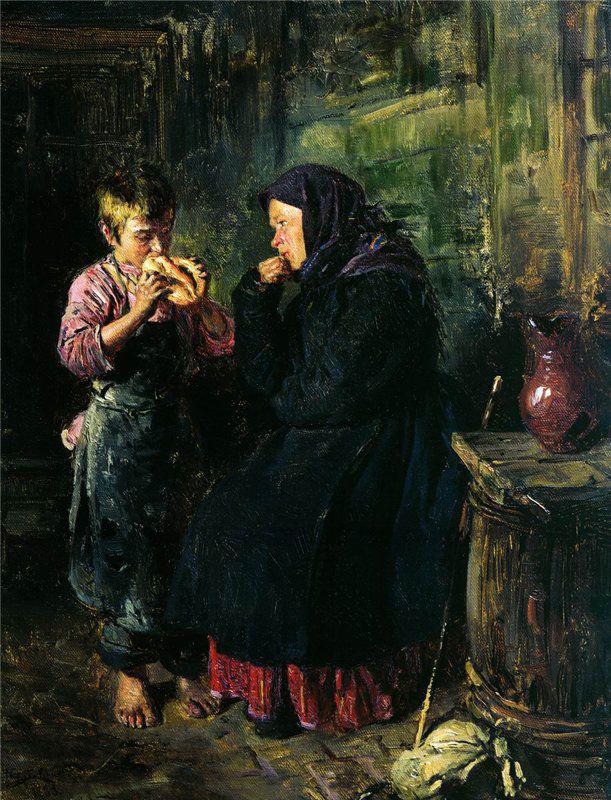
And Vladimir Makovsky. "The collapse of the bank." 1881
The crowd defrauded investors in the bank office. All in shock. Rogue banker (right) quietly dumps with loot. Police looking the other way, such as does not see it.
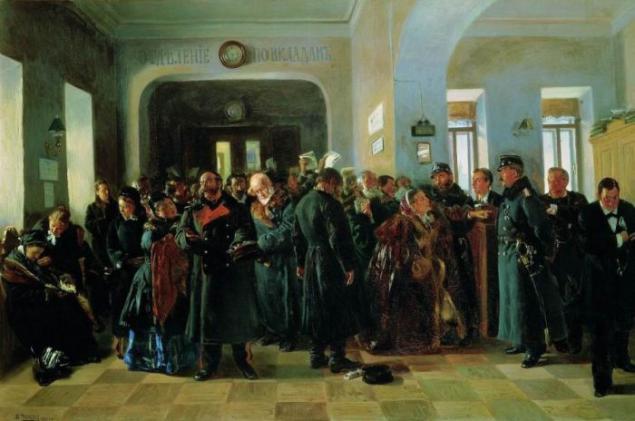
Pavel Fedotov. "Fresh Cavalier." 1846
The young officer received the first order. We wash all night. The next morning, wearing a cross on the right gown, demonstrates his cook. Mad view complete arrogance. Cook, embodies the people looking at him with irony. Fedotov was a master of psychological patterns. The meaning of this: no flashing lights on the machines, and in their heads.

Even Paul Fedotov. "Breakfast aristocrat» .1849-1850.
Morning, impoverished nobleman caught unawares unexpected guests. His breakfast (piece of black bread), he hastily covers the French novel. Nobles (3% of the population) were privileged class in the old Russia. Owned lots of land in the country, but a good farmer are rarely obtained. Do not lordly thing. As a result - poverty, debt, and all laid remortgaged banks. In Chekhov's "The Cherry Orchard" landowner Ranevskaya estate sold for debts. Buyers (rich merchants) derbanit estate, and one very necessary manor cherry orchard (to resell under the summer). The reason for the problems of the family Ranevskayas - idleness for several generations. No one involved in the estate, and the mistress of the last 5 years living abroad and littered with money.
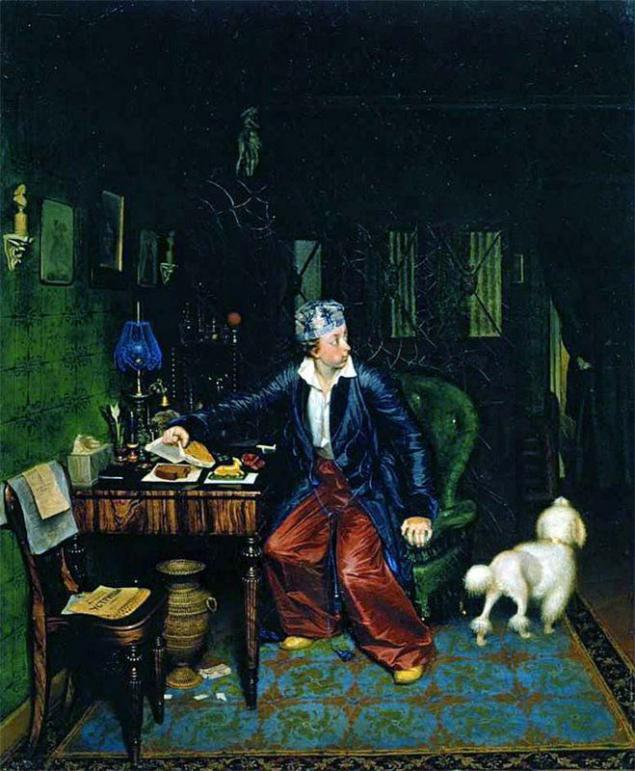
Boris Kustodiev. "Merchant". 1918
The provincial merchant class - a favorite theme in Kustodiev. While the nobles in Paris squandered the estate, these people were raised from the bottom, making money in a huge country where you where to put your hands and capital. It is noteworthy that the picture painted in 1918 when kustodievskih merchants and bills of sale across the country already hard put to the wall of the fighters with the bourgeoisie.
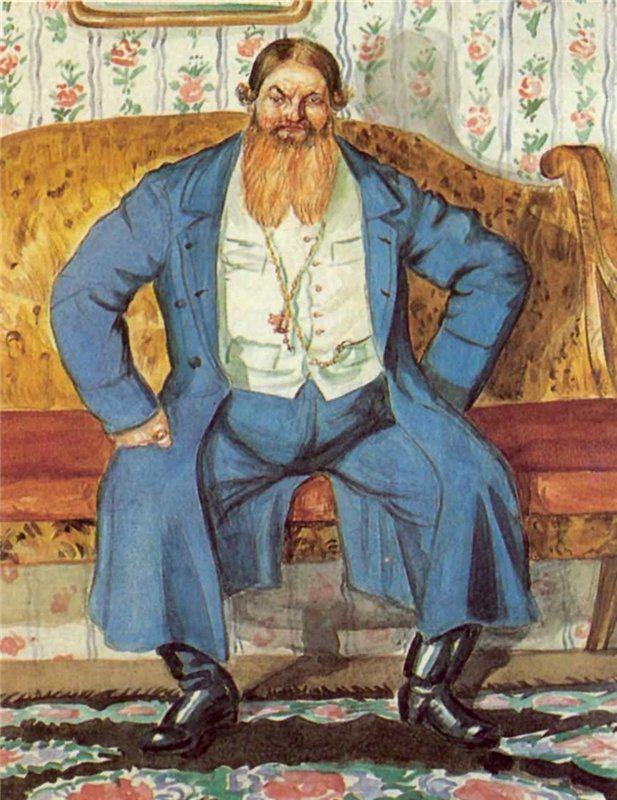
Ilya Repin. "Religious Procession in Kursk Province". 1880-1883 gg.
In the procession out the different layers of society, and Repin painted them all. Ahead carry a lantern with candles behind it - an icon, then go to the best people - officials in uniforms, priests in gold, merchants, nobles. On the sides - Protection (riding) on - the common people. The people on the roadsides ogrebaet periodically, so as not to undercut the heads and climbed on his band. Tretyakov did not like the picture policeman (right, in white, with all the dope peel whip someone from the crowd). He asked the artist to remove this Cop chaos of the plot. But Repin refused. A picture of the Tretyakov bought anyway. For 10 000, which was just a colossal amount at the time.
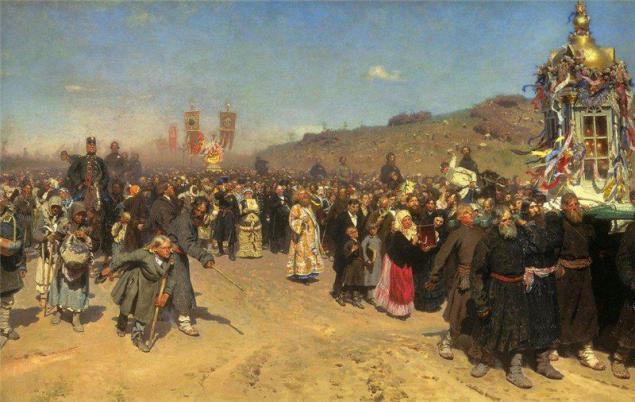
Ilya Repin. "Gathering of." 1883
But these young guys on another painting Repin - do not go with the crowd on all sorts of processions. They have their own way - terror. This "Narodnaya Volya", an underground organization of revolutionaries who killed Tsar Alexander II.
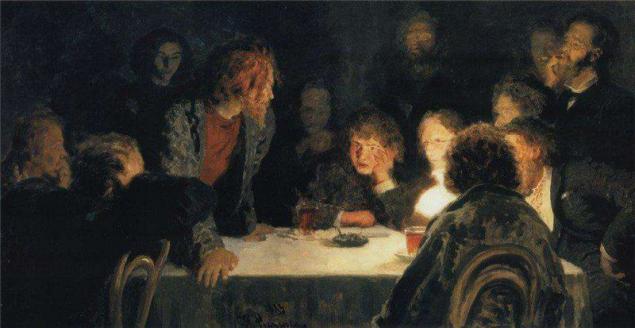
Nikolay Bogdanov-Belsky. "Mental calculation. In folk school S.A.Rachinskogo. " 1895
Rural School. Peasant children in sandals. But the desire to learn - there. The teacher - in a European suit with butterfly. This is a real person - Sergei Raczynski. Mathematician, a professor at Moscow University. On a voluntary basis, he taught in a rural school in the village. Tatevo (now Tver region.), Where he had an estate. Great deal. According to the census in 1897 the literacy rate in Russia was only 21%.
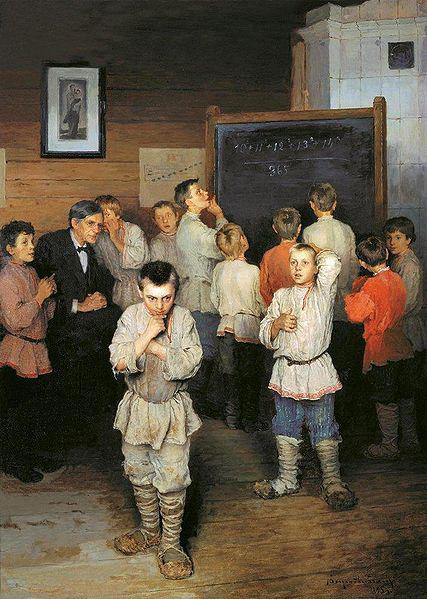
Jan Matejko. "Clad Poland." 1863
According to the 1897 census, literacy in the country was 21%, and the Great - 44%. Empire! Inter-ethnic relations in the country have never been smooth. The painting by Polish artist Jan Matejko was written in memory of the anti-Russian uprising in 1863 Russian officers with the evil mugs shackled girl (Poland), defeated but not broken. Behind it sits another girl (blonde), which symbolizes Lithuania. Her dirty paw another Russian. Pole Right, sitting face to the viewer - the spitting image of Dzerzhinsky.
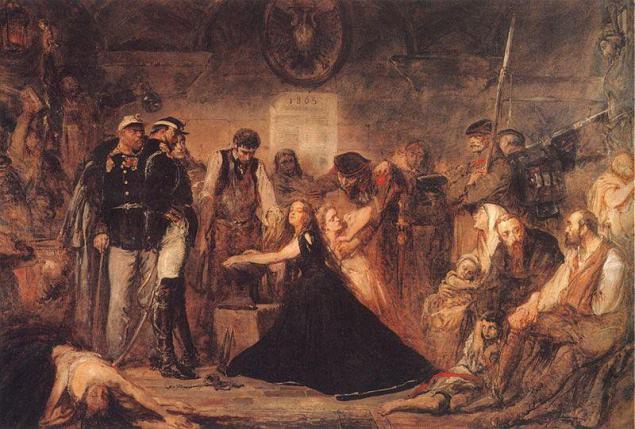
Nikolai Pimomenko. "The victim of fanaticism." 1899
The painting izbrazhen real case that was in Kremenets (Zap.Ukraina). She fell in love with a Ukrainian-Jewish blacksmith. Young decided to get married bride's transition to Christianity. This bothered the local Jewish community. They behaved extremely intolerant. Parents (right in the picture) disowned his daughter, and the girl was subjected to obstruction. The victim in the neck is visible cross in front of her with his fists rabbi, after him - the public concerned with clubs.

Franz Roubaud. "Storm Gimry village." 1891
Caucasian war of the 19th century. Hell batch dagov Chechens and the royal army. Aul Gimry (native village of Shamil) fell 17 October 1832 By the way, since 2007 in the village again Gimry valid counterterrorist operation. Last (at the time of writing this post) riot police sweep was April 11, 2013 The first - in the picture below:
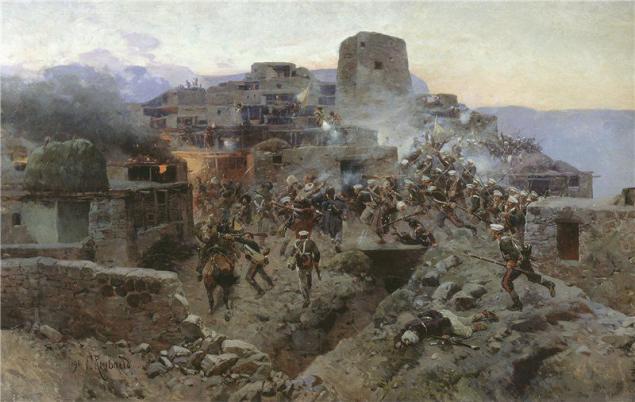
Vasily Vereshchagin. "Opiumoedy." 1868
Vereshchagin painting was in Tashkent during one of the campaigns of the Russian Army Turkestan. Central Asia was then part of Russia. What saw Marcher ancestors of the present migrant workers - this left Vereshchagin painting and memoirs. Dirt, poverty, dope ...

Peter Belousov. "We'll go the other way!". 1951
And finally, the main event in the history of 19th century Russia. April 22, 1870 in the city of Simbirsk was born Vladimir Ulyanov. His older brother, Narodnaya Volya, tried his hand, was in the field of individual terror - are preparing an attempt on the king. But the attempt fell through, and his brother was hanged. That's when the legend of a young Volodya told his mother: "We'll go the other way!". And they went.

Source: uglich-jj.livejournal.com
The situation in the poor house, crawling on the floor of a shabby child, a daughter older dad brought from modest fairing - a bunch of bagels. However, many children in the family - just a picture of the three plus maybe one more in a makeshift cradle.

Nikolai Nevrёv. "Bargaining. Scene from a serf life. " 1866
One landowner sells the land to another girl. Impressively shows the buyer the five fingers - five hundred rubles. 500 rubles - the average price of Russian serfdom in the first half of the 19th century. Seller girls - European-educated gentleman. Paintings on the walls, books. The girl obediently waiting for their fate, others slaves crowded into the doorway and watch what the outcome of bargaining. Tosca.

Vasily Perov. "Rural procession on Easter." 1861
Russian village of the 19th century. Orthodox Easter. All are drunk in the trash, including pop. Man in the center of the icon brings up the legs and about to fall. Some have already fallen. Fun! The essence of the picture - the commitment of the Russian people to Orthodoxy exaggerated. Perov was a recognized master of genre painting and portraiture. But this picture of him in Tsarist Russia was forbidden to display and playback. Censorship!

Gregory Myasoedov. "Zemstvo dinner". 1872
Times of Alexander II. Serfdom was abolished. Permission for local government - zemstvo. Peasants there too chose. But between them and the higher classes - the abyss. So - dining apartheid. Lord - in the house, with the waiters, farmers - under the door.

Fyodor Vasilyev. "The Village" was .1869
1869. The landscape is beautiful and the village, if you look closely, a beggar. Miserable home, leaky roof, buried in the dirt road.

Jan Hendrik Verheijen. "Dutch village with figures of people." 1st floor. 19th century.
Well it is, for comparison :)

Sergey Korovin. "In the world" .1893 Mr.
This is the village of the late 19th century. Serfs no more, but there was a bundle - the kulaks. At the village meeting - any dispute between the poor and the fist. For the poor theme, apparently, vital, he almost cries. Rich fist laughs at him. Other fists in the background, too, giggling over the loser-rogue. But the poor fellow to the right of it was filled with words. Two finished Kombed already a member, have to wait for 1917.

Vasily Maximov. "The auction for the arrears" .1881-82 years.
Tax lyutuet. Royal officials let the hammer samovars, iron pots and other belongings peasant. The most heavy taxes on peasants were indemnity payments. Alexander II «Liberator" actually freed the peasants for the money - then they had to for many years to pay the native state of plots of land that they were given, along with the will. In fact, this land was the peasants before, they used it for many generations, while they were serfs. But when it became available - they were forced to pay for this land. The board had to be made in installments, right up to 1932. In 1907, against the background of the revolution government abolished these levies.

Vladimir Makovsky. "On the Boulevard". 1886-1887 was
At the end of the 19th century. Russia came in industrialization. Young people going into the city. There she goes the roof. Former life they no longer interesting. And this young laborer - not interested even his wife, peasant, came to him out of the village. She did not move forward. Girl in horror. Proletarian with an accordion - all of FIG.

Vladimir Makovsky. "Rendezvous". 1883
In the village of poverty. Kid gave "to the people." Ie sent to the city to work for the owner, who operates child labor. My mother came to visit her son. Tom obviously unsweetened live, the mother sees everything. The kid eats greedily had brought a loaf.

And Vladimir Makovsky. "The collapse of the bank." 1881
The crowd defrauded investors in the bank office. All in shock. Rogue banker (right) quietly dumps with loot. Police looking the other way, such as does not see it.

Pavel Fedotov. "Fresh Cavalier." 1846
The young officer received the first order. We wash all night. The next morning, wearing a cross on the right gown, demonstrates his cook. Mad view complete arrogance. Cook, embodies the people looking at him with irony. Fedotov was a master of psychological patterns. The meaning of this: no flashing lights on the machines, and in their heads.

Even Paul Fedotov. "Breakfast aristocrat» .1849-1850.
Morning, impoverished nobleman caught unawares unexpected guests. His breakfast (piece of black bread), he hastily covers the French novel. Nobles (3% of the population) were privileged class in the old Russia. Owned lots of land in the country, but a good farmer are rarely obtained. Do not lordly thing. As a result - poverty, debt, and all laid remortgaged banks. In Chekhov's "The Cherry Orchard" landowner Ranevskaya estate sold for debts. Buyers (rich merchants) derbanit estate, and one very necessary manor cherry orchard (to resell under the summer). The reason for the problems of the family Ranevskayas - idleness for several generations. No one involved in the estate, and the mistress of the last 5 years living abroad and littered with money.

Boris Kustodiev. "Merchant". 1918
The provincial merchant class - a favorite theme in Kustodiev. While the nobles in Paris squandered the estate, these people were raised from the bottom, making money in a huge country where you where to put your hands and capital. It is noteworthy that the picture painted in 1918 when kustodievskih merchants and bills of sale across the country already hard put to the wall of the fighters with the bourgeoisie.

Ilya Repin. "Religious Procession in Kursk Province". 1880-1883 gg.
In the procession out the different layers of society, and Repin painted them all. Ahead carry a lantern with candles behind it - an icon, then go to the best people - officials in uniforms, priests in gold, merchants, nobles. On the sides - Protection (riding) on - the common people. The people on the roadsides ogrebaet periodically, so as not to undercut the heads and climbed on his band. Tretyakov did not like the picture policeman (right, in white, with all the dope peel whip someone from the crowd). He asked the artist to remove this Cop chaos of the plot. But Repin refused. A picture of the Tretyakov bought anyway. For 10 000, which was just a colossal amount at the time.

Ilya Repin. "Gathering of." 1883
But these young guys on another painting Repin - do not go with the crowd on all sorts of processions. They have their own way - terror. This "Narodnaya Volya", an underground organization of revolutionaries who killed Tsar Alexander II.

Nikolay Bogdanov-Belsky. "Mental calculation. In folk school S.A.Rachinskogo. " 1895
Rural School. Peasant children in sandals. But the desire to learn - there. The teacher - in a European suit with butterfly. This is a real person - Sergei Raczynski. Mathematician, a professor at Moscow University. On a voluntary basis, he taught in a rural school in the village. Tatevo (now Tver region.), Where he had an estate. Great deal. According to the census in 1897 the literacy rate in Russia was only 21%.

Jan Matejko. "Clad Poland." 1863
According to the 1897 census, literacy in the country was 21%, and the Great - 44%. Empire! Inter-ethnic relations in the country have never been smooth. The painting by Polish artist Jan Matejko was written in memory of the anti-Russian uprising in 1863 Russian officers with the evil mugs shackled girl (Poland), defeated but not broken. Behind it sits another girl (blonde), which symbolizes Lithuania. Her dirty paw another Russian. Pole Right, sitting face to the viewer - the spitting image of Dzerzhinsky.

Nikolai Pimomenko. "The victim of fanaticism." 1899
The painting izbrazhen real case that was in Kremenets (Zap.Ukraina). She fell in love with a Ukrainian-Jewish blacksmith. Young decided to get married bride's transition to Christianity. This bothered the local Jewish community. They behaved extremely intolerant. Parents (right in the picture) disowned his daughter, and the girl was subjected to obstruction. The victim in the neck is visible cross in front of her with his fists rabbi, after him - the public concerned with clubs.

Franz Roubaud. "Storm Gimry village." 1891
Caucasian war of the 19th century. Hell batch dagov Chechens and the royal army. Aul Gimry (native village of Shamil) fell 17 October 1832 By the way, since 2007 in the village again Gimry valid counterterrorist operation. Last (at the time of writing this post) riot police sweep was April 11, 2013 The first - in the picture below:

Vasily Vereshchagin. "Opiumoedy." 1868
Vereshchagin painting was in Tashkent during one of the campaigns of the Russian Army Turkestan. Central Asia was then part of Russia. What saw Marcher ancestors of the present migrant workers - this left Vereshchagin painting and memoirs. Dirt, poverty, dope ...

Peter Belousov. "We'll go the other way!". 1951
And finally, the main event in the history of 19th century Russia. April 22, 1870 in the city of Simbirsk was born Vladimir Ulyanov. His older brother, Narodnaya Volya, tried his hand, was in the field of individual terror - are preparing an attempt on the king. But the attempt fell through, and his brother was hanged. That's when the legend of a young Volodya told his mother: "We'll go the other way!". And they went.

Source: uglich-jj.livejournal.com
Tags
See also
Russian invention, to conquer the world
Best movies of the 21st century, filmed in Russia
Exhibition of Wax
Museum of Contemporary History of Russia
Myths about the Great Patriotic War
Russian villains eyes of American directors
Prison "Crosses"
Grand Prix Formula 1 in Russia
24 signs that you have lived in Russia for too long

















